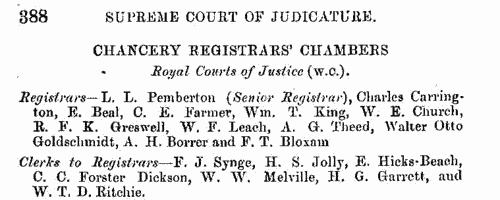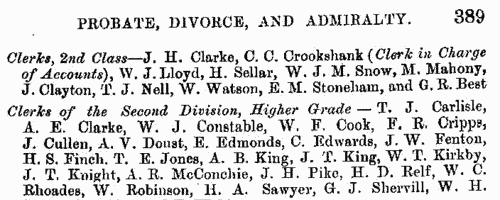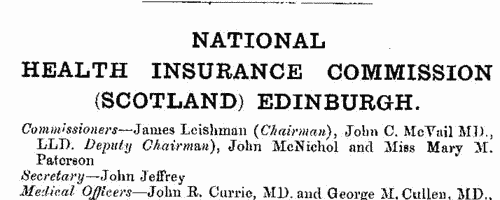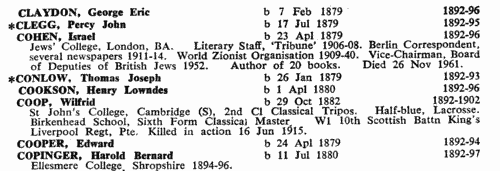Add this eBook to your basket to receive access to all 320 records. Our indexes include entries for the spelling eve. In the period you have requested, we have the following 320 records (displaying 271 to 280): These sample scans are from the original record. You will get scans of the full pages or articles where the surname you searched for has been found. Your web browser may prevent the sample windows from opening; in this case please change your browser settings to allow pop-up windows from this site.  Queen's South Africa Medal: Royal Field Artillery: 86th Battery
(1901-1905) Queen's South Africa Medal: Royal Field Artillery: 86th Battery
(1901-1905)
The nominal roll for the Queen Victoria's South Africa Medal - awarded (after her death, in the event) to all who had served honourably in the various campaigns in the Boer War - was compiled from these returns from the individual units. Two sets of form were completed. The main one, as in the sample scan, dates from 1901 and gives regimental number, rank, and full name (surname first), followed by a series of columns relating to different actions - Belmont, Modder River, Paardeberg, Dreifontein, Wepener, Johannesburg, Diamond Hill, Belfast, Wittebergen, Defence of Kimberley, Relief of Kimberley, Defence of Mafeking, Relief of Mafeking, Cape Colony, Orange Free State, Transvaal, Rhodesia, Talana, Elandslaagte, Tugela Heights, Defence of Ladysmith, Relief of Ladysmith, Laing's Nek, and Natal; each entitled the man to a separate clasp to the medal, and a tick or a Yes in the appropriate column indicates the man's actual physical presence in that battle. A final column for remarks is important in those cases where the man was no longer in the unit, by removal, death or desertion. The second form that sometimes occurs was returned in 1905, and covers men entitled to the Second South African War Medal and Clasps. It lists men by number, rank and name, checks whether they had claimed the Queen's South Africa Medal, and then enquires as to their suitability as to three Colony Clasps, which could be awarded for service in the Cape, Orange Free, or Transvaal; whether entitled to Date Clasps (South Africa 1901 and South Africa 1902); whether also entitled to the King's South Africa Medal; any other corps in which served in South Africa; and remarks (such as becoming non-effective, forfeiture, &c.) WO 100/143 | Sample scan, click to enlarge

| Hampstead Chess Team (1905)
Members of the local chess team named in the results of tournaments recorded in the British Chess Magazine
| Sample scan, click to enlarge

| Students at the London School of Economics
(1905-1906)
An alphabetical list of students attending the London School of Economics during the academic year 1905-1906: the list gives surnames and initials. Women students are distinguished by an asterisk. A superscript 1 indicates that the student has passed one of the Oxford Honours Schools examinations; a superscript 2 that he or she has passed one of the Cambridge Triposes.
| Sample scan, click to enlarge

| Civil Servants and Office Holders
(1907)
The Imperial Calendar gives lists of officials and office-holders throughout England, Wales, Scotland and Ireland
| Sample scan, click to enlarge

| Civil Servants and Office Holders
(1910)
The Imperial Calendar gives lists of officials and office-holders throughout England, Wales, Scotland and Ireland
| Sample scan, click to enlarge

|  London Metropolitan Police
(1902-1911) London Metropolitan Police
(1902-1911)
The London Metropolitan Police Register of Joiners (MEPO 4/337) lists policemen joining the force 14 July 1902 to 10 April 1911 (warrant numbers 88812 to 100006). The register is alphabetical, in so far as the recruits are listed chronologically grouped under first letters of surname. It gives Date of Appointment, Name, Number of Warrant, Cause of Removal from Force (resigned, dismissed, promoted or died), and Date of Removal. The information about removal is sometimes wanting. A final column of 'Remarks' is largely blank, but occasionally gives an alias or a cross-reference to another warrant number. The register is discoloured and damaged in places, and one or two pages are missing. | Sample scan, click to enlarge

| Civil Servants and Office Holders
(1913)
The Imperial Calendar gives lists of officials and office-holders throughout England, Wales, Scotland and Ireland
| Sample scan, click to enlarge

| Boys entering Manchester Grammar School
(1916)
This Biographical Register of Old Mancunians lists boys alphabetically by year of entering the school. A bare register of entrants existed from 1888 onwards but it was only since the Second World War that any kind of detailed record was kept of those who passed through the school. So, in every case in this printed register, full name is given, in bold, surname first (in capitals); date of birth, and years attending the school; but for the earlier years sometimes there is no more information - or, equally, after investigation among Old Mancunians and published sources, the editors may have been able to furnish a condensed biography. An asterisk indicates a holder of a Foundation Scholarship. In the later years a current address is also given, as of 1964 to 1965, when the book was prepared. | Sample scan, click to enlarge

| Gardeners of Country Houses in Middlesex
(1917)
The Horticultural Directory and Year Book was published for 57 years by the proprietors of the Journal of Horticulture, but for 1917 it was acquired by the Gardeners' Chronicle, and a complete revision was undertaken. 'In order to ensure the accuracy of the entries, enquiries were sent to every one of the many thousand persons whose names appeared in the lists. Nor did the work cease there, for in cases where no reply was received, a second enquiry, and in some instances even a third, was sent out. Inasmuch as the War has called many gardeners from their normal avocations, it was not possible to obtain information with respect to all the changes which occurred during the year, and particularly during the closing months. It became necessary, therefore, either to go to press with a certain number of unverified entries or to omit them altogether. After careful consideration, the latter course was adopted, and every unverified entry has been omitted.'
Pages 75 to 187 of the work are occupied by 'A County Directory of the Principal Gardens in Great Britain and Ireland, including Name of Proprietor, Gardener, and Post Town.' This lists country houses possessing substantial gardens tended by a professional gardener. | Sample scan, click to enlarge

| Grenadier Guards Died in the Great War: Guardsmen
(1914-1918)
203 officers and 4508 other ranks of the Grenadier Guards were killed in the Great War; 242 officers and 6939 men were wounded. This nominal roll lists all the warrant officers, non-commissioned officers and men killed in action, or who died of wounds or disease, in the European war of 1914 to 1918. Arranged alphabetically for each rank, the roll gives regimental number, surname and initials. | Sample scan, click to enlarge

|
Research your ancestry, family history, genealogy and one-name study by direct access to original records and archives indexed by surname.
|












